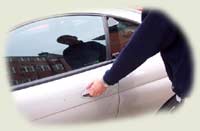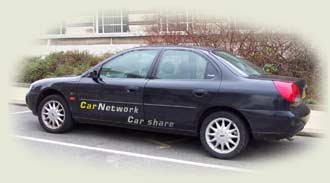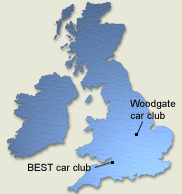


 



  
|

Taxonomy and description
Terminology
Styles of Car Club
Levels of charge
Technology
Terminology
 Car
clubs are usually organised schemes, which members of the public can join
to gain access to a vehicle for short periods of time. Elsewhere in Europe
and in North America, car clubs are often referred to as car sharing.
Car clubs differ from hiring a car in that club members pay an annual
membership fee and can book a car either by telephone or using the internet
for anything from a couple of hours to a couple of days. A mileage fee
is charged to cover fuel costs. In most clubs, members would collect and
return the car from a centrally located parking bay with no administration
beyond booking the vehicle. The cars are generally obtained through a
long term lease from a hire company by the club organisers, although a
group of individuals can establish their own club. Clubs can own anything
from one vehicle to a few hundred, with the geographical area and number
of club members served ranging accordingly. Car
clubs are usually organised schemes, which members of the public can join
to gain access to a vehicle for short periods of time. Elsewhere in Europe
and in North America, car clubs are often referred to as car sharing.
Car clubs differ from hiring a car in that club members pay an annual
membership fee and can book a car either by telephone or using the internet
for anything from a couple of hours to a couple of days. A mileage fee
is charged to cover fuel costs. In most clubs, members would collect and
return the car from a centrally located parking bay with no administration
beyond booking the vehicle. The cars are generally obtained through a
long term lease from a hire company by the club organisers, although a
group of individuals can establish their own club. Clubs can own anything
from one vehicle to a few hundred, with the geographical area and number
of club members served ranging accordingly.
A car club differs from conventional hiring in that access to the vehicles
requires membership of the car club organisation and provides greater
flexibility in that vehicles can be booked out for very short periods
of time. This means that aside from the relatively small joining/membership
fees, the member pays for use rather than access to a car for a whole
day, weekend, week or other period. For example, a club member could book
a vehicle for one hour in the morning and an hour in the evening, just
taking possession of the car for those periods. Consequently, only those
hours are paid for. To obtain the same level of access via conventional
car hire, it is probable that the vehicle would need to be booked out
for 24 hours at a much greater cost.

 Styles
of Car Club Styles
of Car Club
The most basic, and therefore, lowest cost, model for a car club is a
group of individuals purchasing a vehicle between them and making arrangements
for using the car on a one to one basis. It is likely that the car would
be based at a member's house in this situation. The club may not be seeking
to grow, merely serve the needs of members, thus the desire for profit
may be low. The geographical area served by the club is likely to be small.
At the other end of the scale, clubs can be established in partnership
with local authorities and/or transport operators. Vehicles can be obtained
on long term lease from a hire organisation and be equipped with high
tech access and tracking systems. The vehicles are likely to be parked
at specified bays in the area served, and once booked can be accessed
with a security tag identifying the bearer to an on board computer. The
booking procedure is likely to be over the telephone via a call centre,
and/or the internet. Additionally, the desire to expand and make a profit
is likely to be greater. Thus, the geographical area served can eventually
encompass entire countries. The Swiss scheme, "Mobility", which
started back in 1987 now has nationwide coverage with 44,000 members in
350 communities, with 1,750 cars in 900 locations. Despite this, a common
feature of nearly all clubs, is the need for community involvement and
very often a committed community champion in the initial start-up phase.
Once a club is established, links can be formed with public transport
providers, giving members discounted public transport journeys. Such a
link between Mobility and the Swiss railways resulted in rapid expansion
of club. Mobility is also a member of ECS (European CarShare), an European
umbrella group. Through this, Mobility members can access cars via other
clubs in 80 European cities.

Levels of charge
The charges made by car clubs vary. The variability is a function of the
level of technology involved, the cost of obtaining vehicles and the desire
to make a profit. The larger and more sophisticated the club, the greater
will be the administrative and staffing costs.
The charges made by two clubs in the UK are:
 |
Woodgate car club in Leicester, a low tech club established
and organised by members, charges £100 membership per year,
plus £1.40 per hour of use. Three hours use per week would
therefore cost £6.12 per week regardless of mileage. |
| BEST car club in Bristol, a higher tech club established
and run in partnership with the local authority and transport operator,
charges £25 joining fee, £100 one-off refundable deposit
against accidents, £100 per year membership, £2 per
hour of use and £0.15 per mile. Excluding the one off joining
fee and deposit, three hours use per week would cost £7.92
per week plus mileage. Assuming 10 miles per week, the cost would
be £9.42 per week. |
Source: Sheffield Hallam University, 2001.
Figures at 2001 prices.
For the purposes of comparison, hiring a small car (e.g. Vauxhall, Corsa)
for a day can cost approximately £30 (2002 prices).
Technology
The level of technology involved at the outset of a club is often low,
as nearly all are low-cost, community based organisations designed to
meet local needs. However, as clubs grow the need for technology to facilitate
smooth operations management grows. In line with this, rapid communications
technology developments mean that the cutting edge clubs utilise and rely
on very sophisticated technology. The use of such technology can also
influence consumer perceptions. It is likely that the higher tech services
are perceived as higher quality, more efficient and safer services. Technology
can impact on the following areas of a club's operations, economic viability
and service quality in the following ways:
- Vehicle performance, including environmental credentials
- Information and marketing
- Project management
- Reservations systems (kiosks, automated telephone and internet based)
- Interfaces with other transport systems, e.g. links with public transport
- Vehicle location
- Vehicle access
- Vehicle condition
- Trip logging and billing
- Dynamic mapping and on-board travel information
- Access to emergency services
List taken from Britton E. (Ed), 2000.
An example of the technology available is COCOS (CarSharing Organisation
and Communication System). The central element of the system is an on-board
computer including an electronic immobiliser, sensor-interface and electronic
identification system. The on-board computer can also be connected with
mobile data radio systems, contactless access control systems or electronic
key safe boxes. COCOS is supplied by INVERS GmbH based in Siegen,Germany.
http://www.casharingeurope.org/ext/invers_e/base.htm,
2002.

|




